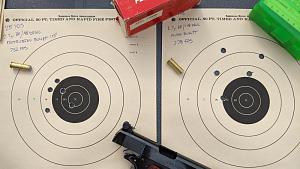Hi, first (original) post here for me.
I recently got back into reloading after a serious hiatus, and am loading handgun cartridges for the first time ever. Not casting (yet) but at least loading cast.
I got some MBC .358 148gr DEWC awhile (like, years) ago and finally got around to loading some up. Went with the traditional recipe, 2.7gr of Bullseye, seated the bullets flush cause that's what one does. At first I was pleased with myself because they function flawlessly, unfortunately the accuracy left something to be desired. Decided to order some different bullets (but they haven't arrived yet). Fast forward to a few nights ago, I was messing around with the crimp function of the seater die and ended up seating a few at the first groove (instead of flush). I realized that I could stuff about 3 of them into a 1911 magazine, and they drop freely into the chamber, so I loaded up some more and took them for a spin.
The results were surprising. The cartridges with the bullet sticking out shoot better. They also run lower velocity (no surprise) and have lower ES and SD. The photo is of sample targets shot back-to-back. Overall I fired a couple dozen rounds of each and the results were consistent. To be absolutely clear, there is no difference between these loads except for the way that the bullet is seated.
So what gives? And, what can I learn from this to make my flush load shoot better?
Thanks


|
   
   
|


|



 Reply With Quote
Reply With Quote











